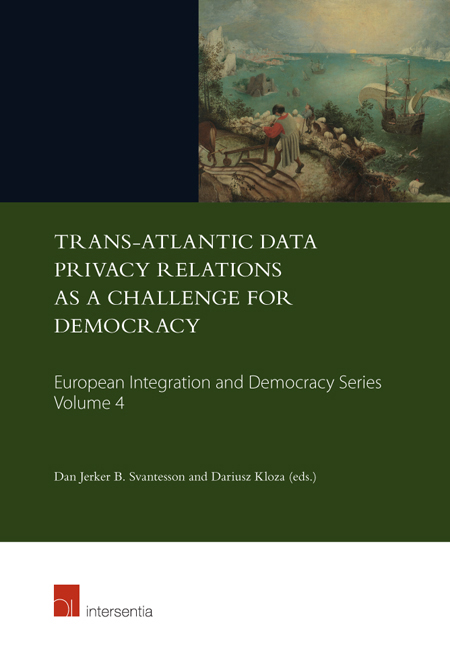Book contents
- Frontmatter
- Foreword
- Preface
- Contents
- List of Abbreviations
- PART I PRIVACY AND …
- SECTION I PRIVACY AND TRANSBORDER FLOWS OF PERSONAL DATA
- 1 Transnational Data Privacy in the EU Digital Single Market Strategy
- 2 Principles for US–EU Data Flow Arrangements
- 3 The Role of Proportionality in Assessing Trans-Atlantic Flows of Personal Data
- 4 US Surveillance Law, Safe Harbour and Reforms Since 2013
- INVITED COMMENTS
- SECTION II PRIVACY AND INTERNATIONAL TRADE
- INVITED COMMENT
- SECTION III PRIVACY AND TERRITORIAL APPLICATION OF THE LAW
- SECTION IV PRIVACY AND CRIME
- INVITED COMMENTS
- SECTION V PRIVACY AND TIME INVITED COMMENTS
- PART II THEORY OF PRIVACY
- PART III ALTERNATIVE APPROACHES TO THE PROTECTION OF PRIVACY
- INVITED COMMENT
- CONCLUSION
4 - US Surveillance Law, Safe Harbour and Reforms Since 2013
from SECTION I - PRIVACY AND TRANSBORDER FLOWS OF PERSONAL DATA
Published online by Cambridge University Press: 29 September 2018
- Frontmatter
- Foreword
- Preface
- Contents
- List of Abbreviations
- PART I PRIVACY AND …
- SECTION I PRIVACY AND TRANSBORDER FLOWS OF PERSONAL DATA
- 1 Transnational Data Privacy in the EU Digital Single Market Strategy
- 2 Principles for US–EU Data Flow Arrangements
- 3 The Role of Proportionality in Assessing Trans-Atlantic Flows of Personal Data
- 4 US Surveillance Law, Safe Harbour and Reforms Since 2013
- INVITED COMMENTS
- SECTION II PRIVACY AND INTERNATIONAL TRADE
- INVITED COMMENT
- SECTION III PRIVACY AND TERRITORIAL APPLICATION OF THE LAW
- SECTION IV PRIVACY AND CRIME
- INVITED COMMENTS
- SECTION V PRIVACY AND TIME INVITED COMMENTS
- PART II THEORY OF PRIVACY
- PART III ALTERNATIVE APPROACHES TO THE PROTECTION OF PRIVACY
- INVITED COMMENT
- CONCLUSION
Summary
INTRODUCTION
This chapter is based on a submission to the Belgian Privacy Authority for its December 2015 Forum on ‘The Consequences of the Judgment in the Schrems Case.’ The Forum discussed the decision of the European Court of Justice in Schrems v Data Protection Commissioner that the EU/US Safe Harbour Agreement was unlawful under the EU Data Protection Directive, particularly due to concerns about US surveillance law.
For the Forum, I was asked to comment on two issues:
1 Is US surveillance law fundamentally compatible with EU data protection law?
2 What actions and reforms has the US taken since the Snowden revelations began in June 2013?
The chapter draws on my background as a scholar of both EU data protection law and US surveillance law The following three sections address serious misunderstandings of US national security law, reflected in official statements made in the Schrems case and elsewhere.
Section 2: The fundamental equivalence of the United States and EU Member States as constitutional democracies under the rule of law. In the Schrems decision, the US was criticised for failing to ensure ‘a level of protection of fundamental rights essentially equivalent to that guaranteed in the EU legal order’ This chapter critiques that finding, instead showing that the United States has strict rule of law, separation of powers, and judicial oversight of law enforcement and national security surveillance, which together make the US legal order ‘essentially equivalent’ to the EU legal order.
Section 3: The section 702 PRISM and Upstream programmes are reasonable and lawful responses to changing technology. The Advocate General's opinion in the Schrems case said that the PRISM programme gave the NSA ‘unrestricted access to mass data'stored in the US, and that section 702 enabled NSA access’ in a generalised manner ‘for’ all persons and all means of electronic communications ‘This chapter refutes those claims, which appear to be based in part on incorrect stories in the press Instead, the section 702 programmes operate with judicial supervision and subject to numerous safeguards and limitations.
- Type
- Chapter
- Information
- Publisher: IntersentiaPrint publication year: 2017



